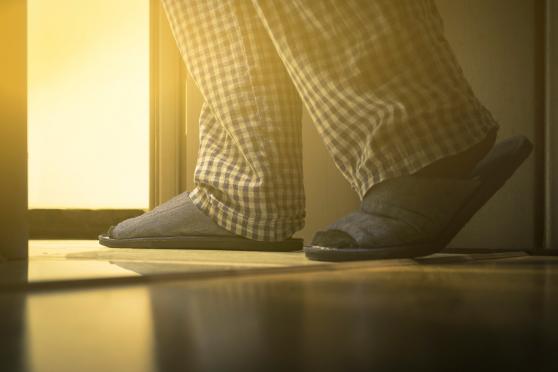Do you think you’d know if you had high blood pressure?
This health condition can go unnoticed for months, even years. Find out what habits put you at risk and how to change them.

High blood pressure.
You likely hear those three words often. Perhaps your doctor brings it up at your annual wellness visits. Maybe friends or relatives take daily readings and share their numbers. And let’s not forget the countless television ads for medications to help control it.
There’s a reason that high blood pressure is talked about so frequently. This condition, also known as hypertension, can cause serious damage to your heart, brain, kidneys, and other vital organs. High blood pressure interferes with the smooth flow of blood through your arteries — the network that carries oxygen and nutrients to your organs and tissues.
A blood pressure reading that is consistently 130/80 or higher means you’re more likely to have a heart attack or stroke, according to the American Heart Association (AHA). Readings less than 120/80 are considered normal; readings between 120/80 and 130/80 are “elevated” and should be closely watched.
But for all the disruption it can cause, high blood pressure itself is quiet. It doesn’t have any glaring signs or symptoms that serve as a calling card. In fact, about one in three adults with the condition aren’t even aware that they have it, reports the National Heart, Lung, and Blood Institute.
High blood pressure doesn’t typically cause noticeable symptoms until it has reached an advanced stage (140/90 or higher), according to the AHA. What’s more, when symptoms do crop up, they can be vague and are often attributed to other causes.
Everything from age to lifestyle to family history plays a role in whether you develop high blood pressure. Read on to learn the factors and daily habits that put you at risk and the top strategies that can help you change them.
Manage your health online in one place — My Account. Sign in or register here.
High blood pressure risk factors that are beyond your control
As with many health conditions, nature dealt each of us a hand that factors into our risk of developing high blood pressure. This includes:
Age. Your blood vessels naturally thicken and stiffen over time, causing blood pressure to go up, explains the National Institute on Aging. Even people who have heart-healthy lifestyles can see a natural, age-related rise in blood pressure.
Family history. Certain genes that run in families can play a role in high blood pressure. If your parents or a sibling have it, you’re more likely to get the condition, too, according to the Mayo Clinic. That’s why this question pops up on the forms you fill out before your annual wellness visit or physical.
Gender. High blood pressure is more common in men throughout middle age. But later in life, it’s more common in women. That’s due to hormonal changes brought on by menopause.
What you can do: You can’t change these risk factors. But you can take care of your health with regular checkups, prioritizing self-care, and working with your doctor to develop an effective treatment plan.
High blood pressure risk factors you can control
Making a few strategic tweaks to your daily routine can go a long way toward keeping your blood pressure in the healthy range (less than 120/80), says Steven Marshall, D.N.P. He’s a doctor of nursing in Madison, North Carolina.
The top daily habits to focus on:
Get a good night’s sleep. Tossing and turning at night or regularly sleeping fewer than seven hours can have a negative effect on blood pressure. Blood pressure naturally goes down when you sleep, so any disruption means that your blood pressure stays higher for a longer period of time. Adult should aim for seven to nine hours a night, according to the National Institutes of Health.
If you have trouble sleeping, talk to your doctor. They can rule out underlying health problems that may be disrupting your sleep patterns and recommend strategies to help you get quality sleep.
Watch your intake of salt, fat, and ultra-processed foods. Regularly eating foods that are high in salt or saturated fat or that are highly processed (i.e., packaged snacks and frozen dinners) increase your risk of developing high blood pressure. Drinking too much alcohol can also raise blood pressure.
Making big dietary changes isn’t always easy. That’s why it’s smart to meet with a registered dietitian. They can set you up with an eating plan that allows for your favorite foods and flavors but helps to bring your blood pressure into a healthy range.
Move more. Regular exercise and sitting less are two of the best things you can do for your overall heart health and your blood pressure.
Adults should aim to get 150 minutes of moderate-intensity aerobic exercise each week, according to government guidelines. That breaks down to about 30 minutes a day, five days a week. But the good news is that you can hit that 150 minute goal any way that works for you.
A few options:
- Take a brisk 10-minute walk after every meal.
- Do one 60-minute group fitness class that you enjoy each week. Do shorter activities on the other days of the week.
- Do a 30-minute gym workout three days a week. Go for short, brisk walks on alternate days.
And remember, many active household chores — such as weeding the garden or pushing a vacuum or lawn mower — count toward your 150-minute exercise target.
With the Silver&Fit® Healthy Aging & Exercise program, staying active is convenient and affordable. You get a fitness center membership at little or no cost. Choose from participating fitness centers statewide. If you want to exercise at home, you can get a Home Fitness Kit at no cost. For information, visit silverandfit.com or call 1 (888) 354-4934.
The Silver&Fit program isn’t available for some HMSA Akamai Advantage employer group plan members. Check your Evidence of Coverage.
If you smoke, quit. Add high blood pressure to the list of health problems connected to smoking. If you’d like to quit but don’t know where to start, visit this webpage at hmsa.com. Read about the Hawai`i Tobacco QuitLine and let your doctor know that you’d like to try it. If your doctor agrees this is a good program for you, call 1 (800) QUIT-NOW (784-8669) or visit hawaiiquitline.org.
Manage stress. The hormones your body releases when you’re faced with a stressful situation make the heart beat faster and cause your blood vessels to constrict. It’s known as the fight-or-flight response and it passes when you’re out of the danger zone. The trouble for your blood pressure arises if you’re constantly stressed and not taking steps to decompress.
There’s no avoiding stress, but there are healthier ways to handle it day-to-day. Regular exercise is one way to help your mind reset, but it’s certainly not the only way.
Many people find mindfulness practices — such as journaling, deep breathing exercises, and meditation — to be helpful for keeping stress at bay. For others it can be as simple as turning off their phone or computer for an hour every day, reading a good page-turner, or calling a friend.

Use Find a Doctor on hmsa.com to search for a participating provider near you today.
Other things that increase the risk of high blood pressure
Certain medical conditions and some common medications can also raise blood pressure, according to the National Heart, Lung, and Blood Institute.
These include:
- Medical conditions, such as chronic kidney disease, sleep apnea, and thyroid problems, among others.
- Medications, such as some antidepressants, many over-the-counter pain relievers, and allergy medicines.
What Black and Hispanic Americans need to know about high blood pressure
High blood pressure is more common in Black and Hispanic Americans. The reasons for this are complex and continue to be studied. Researchers know that some commonly prescribed blood pressure medications are less effective in people of color.
Also, depending on where they live, many people of color don’t have easy access to healthy foods, exercise opportunities, and medical care or health plan, according to studies in Hypertension and the Journal of the American Heart Association.
How to manage your risk of high blood pressure
In addition to adjusting some of your daily routines as noted above, the best thing you can do for your blood pressure is know your baseline reading. You can get that number at your next annual wellness visit.
“It is important to have your blood pressure taken at least once a year at your provider’s office,” says Marshall.
If high blood pressure runs in your family or if you’ve noticed some unusual symptoms, such as more frequent headaches or new episodes of dizziness, talk to your doctor about your risk.
“If you have a family history of high blood pressure, consider purchasing an at-home blood pressure monitoring device,” Marshall says. You can track your blood pressure over time and share those readings with your doctor at your next visit. (For more resources, check out HMSA’s hypertension suppport center.)
When lifestyle changes aren’t enough to lower your blood pressure
Lifestyle changes are typically the first line of treatment when blood pressure readings are consistently between 120/80 and 139/89.
If your elevated blood pressure doesn’t respond to lifestyle changes or if your blood pressure is already very high, your doctor may prescribe a blood pressure medication.
It’s important that you take these medications as prescribed and to watch for side effects so that you can avoid any adverse reactions.
The bottom line: Many of the health problems tied to high blood pressure can be prevented with regular checkups and a few simple lifestyle changes. Taking just one small step each day can add up to better heart health.
Additional sources:
High blood pressure: Centers for Disease Control and Prevention
What is high blood pressure: National Heart, Lung, and Blood Institute
High blood pressure and older adults: National Institute on Aging
Understanding blood pressure readings: American Heart Association
How does blood flow through your body: Cleveland Clinic
High blood pressure dangers: Mayo Clinic
Health threats from high blood pressure: American Heart Association
High blood pressure in adults: National Library of Medicine, Medline Plus
High blood pressure, causes and risk factors: National Heart, Lung, and Blood Institute
Prevent high blood pressure: Centers for Disease Control and Prevention
H3832_4038_8750_5MS585_24_C
© 2023, Linkwell Health, Inc. All content owned or licensed by Linkwell Health, Inc. All rights reserved.
Silver&Fit and the Silver&Fit logo are federally registered trademarks of ASH and used with permission herein. Kits are subject to change. The Silver&Fit program is provided by American Specialty Health Fitness, Inc., a subsidiary of American Specialty Health. ASH is an independent specialty health organization, offering musculoskeletal health provider networks and programs, fitness center networks and programs, and well-being solutions on behalf of HMSA.


